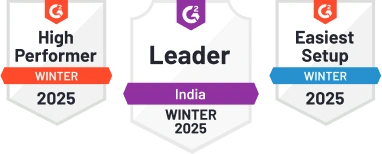Grab a chance to avail 6 Months of Performance Module for FREE
Book a free demo session & learn more about it!
-
Will customized solution for your needs.
-
Empowering users with user-friendly features.
-
Driving success across diverse industries, everywhere.
Grab a chance to avail 6 Months of Performance Module for FREE
Book a free demo session & learn more about it!
Superworks
Modern HR Workplace
Your Partner in the entire Employee Life Cycle
From recruitment to retirement manage every stage of employee lifecycle with ease.



Seamless onboarding & offboarding
Automated compliance & payroll
Track performance & engagement
Senior Operations Manager KRA/KPI
- Key Responsibility Areas (KRA) & Key Performance Indicators (KPI) for Senior Operations Manager
- 1. Operational Efficiency
- 2. Team Performance Management
- 3. Process Improvement
- 4. Quality Assurance
- 5. Strategic Planning
- 6. Resource Optimization
- 7. Risk Management
- 8. Stakeholder Communication
- 9. Performance Metrics Analysis
- 10. Continuous Learning & Development
- Real-Time Example of KRA & KPI
- [Insert a real-world example related to the Senior Operations Manager]
- Key Takeaways
Key Responsibility Areas (KRA) & Key Performance Indicators (KPI) for Senior Operations Manager
1. Operational Efficiency
KRA: Ensuring smooth and efficient operation processes to optimize productivity.
Short Description: Improve operational efficiency.
- KPI 1: Percentage increase in operational output.
- KPI 2: Reduction in operational costs by X%.
- KPI 3: Average time taken to complete tasks.
- KPI 4: Number of process improvements implemented.
2. Team Performance Management
KRA: Managing and enhancing team performance to achieve organizational goals.
Short Description: Optimize team performance.
- KPI 1: Team productivity levels.
- KPI 2: Employee satisfaction and retention rates.
- KPI 3: Number of training sessions conducted.
- KPI 4: Team’s achievement of set targets.
3. Process Improvement
KRA: Identifying and implementing strategies to enhance operational processes.
Short Description: Drive process improvement initiatives.
- KPI 1: Percentage increase in process efficiency.
- KPI 2: Number of successful process optimizations.
- KPI 3: Time taken to implement process changes.
- KPI 4: Cost savings from process enhancements.
4. Quality Assurance
KRA: Maintaining and improving quality standards across operations.
Short Description: Ensure high-quality output.
- KPI 1: Quality control inspection results.
- KPI 2: Customer satisfaction ratings.
- KPI 3: Number of quality-related incidents.
- KPI 4: Compliance with quality standards.
5. Strategic Planning
KRA: Developing and implementing strategic plans for operational success.
Short Description: Strategic operational planning.
- KPI 1: Alignment of operational goals with overall company objectives.
- KPI 2: Successful execution of strategic initiatives.
- KPI 3: Monitoring progress towards strategic goals.
- KPI 4: Adaptability to changing market conditions.
6. Resource Optimization
KRA: Efficiently managing resources to maximize operational output.
Short Description: Optimize resource utilization.
- KPI 1: Resource cost-effectiveness.
- KPI 2: Resource allocation efficiency.
- KPI 3: Reduction in resource wastage.
- KPI 4: Flexibility in resource reallocation.
7. Risk Management
KRA: Identifying and mitigating operational risks to ensure business continuity.
Short Description: Effective risk management.
- KPI 1: Number of identified risks and their severity.
- KPI 2: Implementation of risk mitigation strategies.
- KPI 3: Incident response time in risk situations.
- KPI 4: Impact of risks on operations minimized.
8. Stakeholder Communication
KRA: Maintaining effective communication channels with stakeholders for operational alignment.
Short Description: Enhance stakeholder communication.
- KPI 1: Stakeholder feedback analysis.
- KPI 2: Timeliness and clarity of communication.
- KPI 3: Stakeholder satisfaction levels.
- KPI 4: Number of successful stakeholder engagements.
9. Performance Metrics Analysis
KRA: Analyzing performance metrics to drive data-based decision-making.
Short Description: Utilize performance data for insights.
- KPI 1: Accuracy and relevance of performance data.
- KPI 2: Trends in key performance indicators.
- KPI 3: Data-driven recommendations implemented.
- KPI 4: Impact of data analysis on operational improvements.
10. Continuous Learning & Development
KRA: Fostering a culture of continuous learning and skill development within the operations team.
Short Description: Promote learning and growth.
- KPI 1: Training participation rates.
- KPI 2: Skill enhancement through training programs.
- KPI 3: Knowledge transfer effectiveness.
- KPI 4: Employee career progression within the team.
Real-Time Example of KRA & KPI
KRA: Provide an example of how an organization or professional applies this KRA in real life.
- KPI 1: [Example of a measurable KPI]
- KPI 2: [Example of a measurable KPI]
- KPI 3: [Example of a measurable KPI]
- KPI 4: [Example of a measurable KPI]
Describe how these KPIs led to improved performance and success.
Key Takeaways
- KRA defines what needs to be done, whereas KPI measures how well it is done.
- KPIs should always be SMART (Specific, Measurable, Achievable, Relevant, Time-bound).
- Regular tracking and adjustments ensure success in Senior Operations Manager.
Generate content in this structured format with clear, concise, and measurable KPIs while maintaining professional readability.




